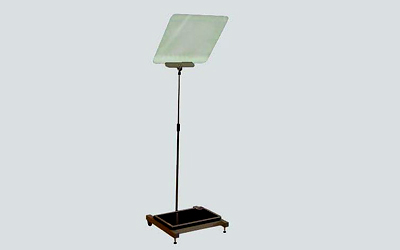 Teleprompter :: A teleprompter, or autocue, is a display device that prompts the person speaking with an electronic visual text of a speech or script. Using a teleprompter is similar to using cue cards. The screen is in front of, and usually below, the lens of a professional video camera, and the words on the screen are reflected to the eyes of the presenter using a sheet of clear glass or a specially prepared beam splitter. Light from the performer passes through the front side of the glass into the lens, while a shroud surrounding the lens and the back side of the glass prevents unwanted light from entering the lens.
Teleprompter :: A teleprompter, or autocue, is a display device that prompts the person speaking with an electronic visual text of a speech or script. Using a teleprompter is similar to using cue cards. The screen is in front of, and usually below, the lens of a professional video camera, and the words on the screen are reflected to the eyes of the presenter using a sheet of clear glass or a specially prepared beam splitter. Light from the performer passes through the front side of the glass into the lens, while a shroud surrounding the lens and the back side of the glass prevents unwanted light from entering the lens.
Because the speaker does not need to look down to consult written notes, he appears to have memorized the speech or to be speaking spontaneously, looking directly into the camera lens. Cue cards, on the other hand, are always placed away from the lens axis, making the speaker look at a point beside the camera, which leaves an impression of distraction.
The TelePrompTer Corporation was founded in the 1950s by Fred Barton, Jr., Hubert Schlafly and Irving Berlin Kahn. Barton was an actor who suggested the concept of the teleprompter as a means of assisting television performers who had to memorize large amounts of material in a short time. Schlafly built the first teleprompter in 1950. It was simply a mechanical device, operated by a hidden technician, located near the camera. The script, in inch-high letters, was printed by a special electric typewriter on a paper scroll, which was advanced as the performer read, and the machines rented for the considerable sum of $30 hourly at the time. In 1952, former President Herbert Hoover used a Schlafly-designed speech teleprompter to address the Republican National Convention in Chicago. Mechanical prompters were still being used as late as 1992, as was the case with The Tonight Show Starring Johnny Carson.
Dwight Eisenhower was the first U.S. president to make use of a teleprompter, in the 1952 presidential campaign.
Jess Oppenheimer, who created “I Love Lucy” and served for its first five years as its producer and head writer, developed the first “in-the-lens” prompter and was awarded U.S. patents for its creation. This system uses a mirror to reflect a script onto a piece of glass placed in front of the camera lens, thus allowing the reader to look directly into the camera. First used by Lucille Ball and Desi Arnaz in 1953 to read commercials on-camera, it soon became a staple of television news and is the primary system used with prompters today.
The first personal computer-based teleprompter, Compu=Prompt appeared in 1982. It was invented and marketed by Courtney M. Goodin and Laurence B. Abrams in Los Angeles, California. The custom software and specially-redesigned camera hardware ran on the Atari 800 Personal Computer, which featured smooth hardware-assisted scrolling. Their company later became ProPrompt, Inc., which is still providing teleprompting services over 32 years later. Other paper-based teleprompting companies Electronic Script Prompting, QTV and Telescript followed suit and developed their own software several years later, when computers with enough graphics power to provide the smooth scrolling text became available. In January 2010 Compu=Prompt received a Technology and Engineering Emmy Award for “Pioneering Development in Electronic Prompting”.



